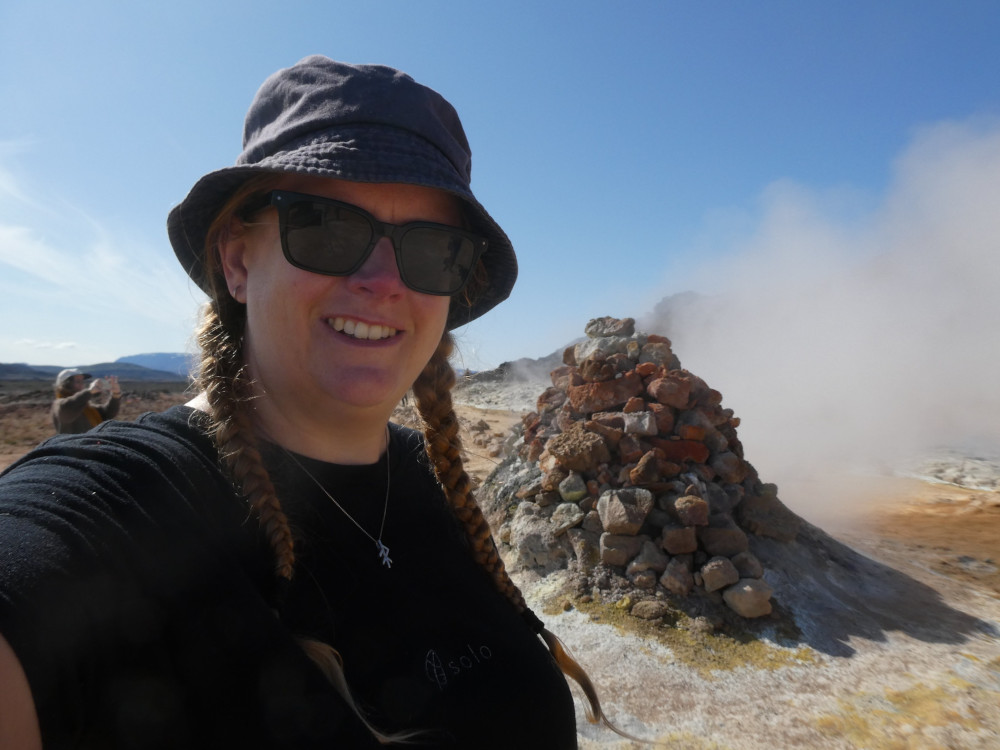I said at the beginning of the year that I was going to work through some gaps and one particularly egregious gap is Hverir, the geothermal area at Mývatn. I love Mývatn. You can never run out of interesting geothermal or volcanic things to see and do, and one particularly popular spot is Hverir.

Hverir literally means the hot springs. Icelandic doesn’t differentiate between exploding hot pools, peaceful hot pools, hot rivers, boiling water running out from between rocks, and places where the ground is blistered and streaked with sulphur. Hverir is the latter. You’ll also see the area called Námafjall because that’s the name of the mountain looming over it.

It’s just a few minutes south of Reykjahlið, the tiny village (home to ~50 souls) which forms the main tourist centre around Mývatn, which is a big shallow lake out in the countryside. You leave Reykjahlið on the Ring Road headed for Egilstaðir and you’ll find Hverir on your left shortly after you’ve swept over the golden-orange shoulder of mountain behind the village. To your right is Krafla – the Eternal Shower, the Krafla geothermal power station, Víti and Leirhnjúkur but more or less opposite is Hverir.

The car park used to be free but as tourist numbers skyrocketed, paid parking also skyrocketed. This is one of those places where you pay by phone, so look out for the sign. It’s right at the start of the path down to the hot bit, you can’t miss it. That means you’ll need to know the registration of the car you’ve rented, just to save you the walk back to it. Or go with a tour company and cover all the interesting things in one day and save the parking cost, that’s another option.

This whole area is geothermally active. That’s why there’s a power station here. Krafla, over on the other side, last erupted in the late 70s/early 80s. I’ve always known the phrase “the Krafla Fires” but it wasn’t until Reykjanes woke up three years ago that I’ve really realised what it meant. It wasn’t a decade-long eruption, flooding the region with fire and lava. It was a series of eruptions, with breaks of days or months in between them, just like what’s going on down by Grindavík and the Blue Lagoon right now. So there’s heat still just below the surface, powering the power station and the Nature Baths and the various caves and crevices full of natural hot water. And of course, Hverir.

The first thing you’ll see from the ridge is a yellow-white field, blistered and cracked, steaming gently and sending up a smell like rotten eggs. That’s mostly sulphur. So are the yellow and white powdery deposits. Tread carefully here. There are boardwalks in places but mostly there’s little more keeping you out of boiling holes than low ropes. The boiling holes are filled with either grey-blue boiling mud or grey-blue boiling water. Step off the path, step on a patch of fragile ground or straight into one of those holes and you can say goodbye to your leg. So stick to the paths and tread carefully. Maybe put on your boots instead of your flipflops for this bit.

You can walk among the boiling mud and the bubbling ground and the steam for as long as you like – as long as you can tolerate the smell. I’ve kind of got to the point where I barely notice it and certainly don’t mind it but I know that everyone is shocked and revolted by it on their first visit. It’s really interesting to see what the volcanic heat just below the ground is doing to the surface. This is all caused by the ground being heated or by the proximity of very hot water. That’s all it is. Imagine an egg in a frying pan. Picture what happens to it as it gets hot, as it gets cooked through. The surface of the ground here is being heated from below, just like the egg, and the surface dries and solidifies and bubbles in just the same way. Or even better, a pancake!

My favourite feature is a thing I call a kettle. Actually, Hverir has two or three of these things. They’re like stone cairns, three or four or even five feet tall, just a vaguely pyramidal pile of stones, which is blasting steam like a kettle coming to the boil. I have no idea how long these things have been here. Are they all a results of the recent Krafla Fires? Or are they older? A similar volcanic experience called the Mývatn Fires happened in more or less the same place in the 1720s. Was that when these kettles were formed? Or are the kettles even older? You don’t want to stand too close to them. If you can keep out of their cloud of steam, that would be good, because it’s very powerful and steam is very hot. It’s just as easy to scald yourself on the steam as it is to burn yourself in the mud pools. However, at a bit more of a distance, if the wind changes (or deliberately, if the day is cold), you can let the edges of the steam rush over you. Far enough away, it’s just a whoosh of damp heat, almost like that moment when you open the oven. Glasses-wearers, they will immediately steam up, so don’t step in anything while temporarily blinded.

I’ve always enjoyed Hverir just wandering around, taking in the sights and sounds and smells but if you want to, there’s a trail leading up the mountain which takes an hour and a half to two hours to complete which means you can look down on the whole thing. If you still want more geothermal and volcanic delights, you’re in the right place – if you like Hverir, I think you’ll like Leirhnjúkur, which is a lava field up by Krafla on the opposite side of the valley.
